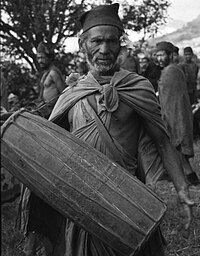
The Chepang, also known as Chewang, are a Tibeto-Burman ethnic group from the rugged ridges of the Mahabharat mountain range of central Nepal.
The Kusunda or Ban Raja, known to themselves as the Mihaq or Myahq, are a tribe of former hunter-gatherers of the forests of western Nepal, who are now intermarried with neighboring peoples and settled in villages.
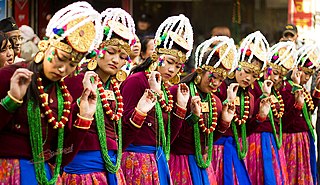
Gurung or Tamu are an ethnic group indigenous to the hills and mountains of Gandaki Province of Nepal. Gurung people predominantly live around the Annapurna region in Manang, Mustang, Dolpo, Kaski, Lamjung, Gorkha, Parbat,Tanahun and Syangja districts of Nepal. They are one of the main Gurkha tribes.
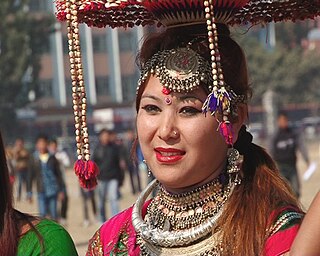
The Tharu people are an ethnic group indigenous to the Terai in southern Nepal and northern India. They speak Tharu languages. They are recognized as an official nationality by the Government of Nepal. In the Indian Terai, they live foremost in Uttarakhand, Uttar Pradesh and Bihar. The Government of India recognizes the Tharu people as a scheduled Indian tribe.

The Tamang, are a Tibeto-Burman ethnic group of Nepal, Southern Bhutan and North India. In Nepal, Tamang/Moormi people constituted 5.6% of the Nepalese population at over 1.3 million in 2001, increasing to 1,539,830 as of the 2011 census. The Tamang people are concentrated in the central hilly region of Nepal. Indian Tamangs are found in significant numbers in the state of Sikkim and the districts of Darjeeling and Kalimpong in West Bengal state. Bhutanese Tamangs are native to various districts in the southern foothills of the Kingdom of Bhutan. Such districts include the Tsirang District, the Dagana District, the Samtse District, the Chukha District, the Sarpang District and the Samdrup Jongkhar District. Tamang language is the fifth most-spoken language in Nepal.
Bisht is a surname found in the Indian state of Uttarakhand, Himachal Pradesh and country Nepal. The term "Bisht" originally referred to someone who held a land grant from the government. The Bisht families in Uttarakhand were chiefly Thokdars(Zamindars) of Thuljat origin. In Uttrakhand, Bishts are generally Kshatriya Rajputs. In Nepal, Bisht was adopted as a surname by Raute and Raji people. Bishta, as Bista, was also used as a surname used by Khas people, group under the caste Chhetri.
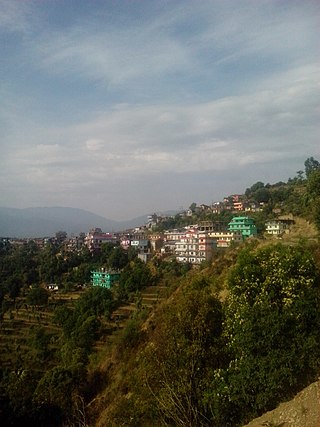
Dadeldhura, a part of Sudurpashchim Province, is one of the seventy-seven districts of Nepal. The district, with Dadeldhura as its district headquarters, covers an area of 1,538 km2 (594 sq mi) and had a population of 126,162 in 2001 and 142,094 in 2011.
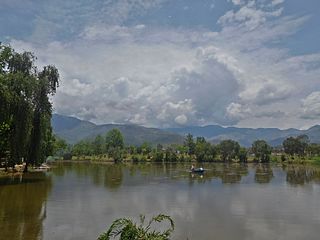
Surkhet District is a district in Karnali Province of mid-western Nepal. Surkhet is one of the ten districts of Karnali located about 600 kilometres (373 mi) west of the national capital Kathmandu. The district's area is 2,489 square kilometres (961 sq mi). It had 288,527 population in 2001 and 350,804 in 2011 which male comprised 169,461 and female 181,381. Its district headquarters, Birendranagar, is the capital of Karnali Province. It is serving as a business hub and document center for Karnali province. According to population, development, road links, landforms, climate, many peoples are migrating here. After becoming province capital developmental activities are boosted and are in peak level. All the governmental works are carried here. Birendranagar is beautiful valley surrounded by hills having moderate climate.
The Banrawats are a native endangered ethnic minority group, originating and living in Uttarakhand, India. They are distributed in the districts of Pithoragarh, Champawat and Udham Singh Nagar and in a small area confined to Western Nepal. They are the smallest Himalayan tribal group related to a larger ethno-linguistic group of Raji people. They are basically nomadic hunter-gatherers, but also work as agriculture and forest labourers. They are mainly dependent on forests, and also practice shifting cultivation. Their existence is threatened by developmental and wild life related projects. They were placed in forced settlements by the Government of India beginning in the 1980s. Many continue to move in semi-nomadic camps, but most are now settled into villages along the Mahakali River area straddling India.

Johan Reinhard is an American anthropologist and archaeologist. He is Explorer-in-Residence at the National Geographic Society. He is also a senior research fellow at The Mountain Institute, a visiting professor at Catholic University, Salta, Argentina, an honorary professor of Catholic University, Arequipa, Peru, and a research professor at Future Generations University.
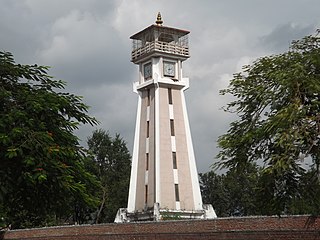
Birendranagar officially Birendranagar Municipality is a city in Surkhet District in Karnali Province of Nepal. It is the capital city of Karnali province as well as the district headquarter of Surkhet district. As of March 2022, Birendranagar has a population of 154,886, making it the 17th most populous city of Nepal. Birendranagar is the largest city of Karnali province and 7th largest in Western Nepal. It is one of the fastest growing cities of Nepal and is on two national highways, Ratna Highway and Karnali Highway. It is one of the constituent city of the Ratna Highway Metropolitan Areas along with Nepalgunj and Kohalpur. Birendranagar compromises of panoramic view of Mahabharata and Chure ranges and the plain of the inner Terai. A major trade center in mid-western Nepal, Birendranagar is considered the most expensive city to live in Nepal.
The Dhimal or Dhemal are an Kirati ethnic group residing in the eastern Terai of Nepal. They are a Sino-Tibetan-speaking ethnic group of the eastern Terai. They mainly reside in Morang and Jhapa districts of Nepal and Darjeeling district of West Bengal, India. They are respected as the "First Citizens" of Damak municipality.
Raji–Raute is a branch of the Sino-Tibetan language family that includes the three closely related languages, namely Raji, Raute, and Rawat. They are spoken by small hunter-gatherer communities in the Terai region of Nepal and in neighboring Uttarakhand, India.
The Chepangic languages, Chepang and Bhujel, are Sino-Tibetan languages of uncertain affiliation spoken in Nepal. They are often classified as part of the Mahakiranti or Magaric families.
Thangmi, also called Thāmī, Thangmi Kham, Thangmi Wakhe, and Thani, is a Sino-Tibetan language spoken in central-eastern Nepal and northeastern India by the Thami people. The Thami refer to their language as Thangmi Kham or Thangmi Wakhe while the rest of Nepal refers to it as Thāmī. The majority of these speakers, however, live in Nepal in their traditional homeland of Dolakhā District. In India, the Thami population is concentrated mostly in Darjeeling. The Thangmi language is written using the Devanagari script. Thangmi has been extensively documented by Mark Turin.
Raute is a small Sino-Tibetan language of Dadeldhura District, Sudurpashchim Province, Nepal. Some speakers are nomadic.
Raji is a small Sino-Tibetan language of Nepal and Uttarakhand, India. Speakers were until recently nomadic.
Rawat (Raute), or "Jangali" (Jungle), is a small Sino-Tibetan language of India. It is spoken in 9 villages north of Askot in Pithoragarh district, Uttarakhand, India (Ethnologue) as well as in several villages in Dadeldhura District, Nepal and Darchula District, Nepal.
The Raji people are a community found in Uttarakhand, India and some parts of western Nepal. As of 2001, the Raji people are classified as a Scheduled Tribe under the Indian government's reservation program of positive discrimination.

Dor Bahadur Bista is a Nepalese anthropologist, social scientist and activist. Bista is considered the Father of Nepali anthropology, and has published popular books such as Fatalism and Development and People of Nepal. Bista mysteriously disappeared in 1995.
